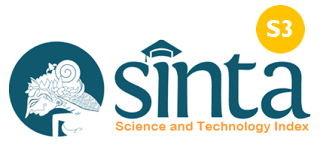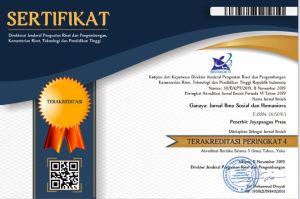Upaya Pelestarian Lingkungan Desa Bongkasa Berdasarkan Ajaran Tri Hita Karana
DOI:
https://doi.org/10.37329/cetta.v5i4.3110Keywords:
Environmental Preservation, Bongkasa Village, Tri Hita KaranaAbstract
Preservation of the village environment is very important to do as a form of maintaining a comfortable and healthy village environment for the continuity of community life in the future and in the long term. Preservation of the village environment is not only done in tourist villages. Preserving the environment is very important, this makes village communities in Bali, especially in Bongkasa Village, must have a good strategy in preserving the village environment. This study uses a qualitative research approach and type by utilizing literature study or literature study as the main technique in collecting information. Tri Hita Karana is three concepts used as an effort to preserve the environment of Bongkasa Village. These three concepts consist of parahyangan, which is a good relationship with God, such as cultivating flowers and fruit plants that can be used as a means of complementing ceremonies, celebrating the holy day of tumpek wariga as a form of expression of gratitude to God for all the abundance of crops, cleaning the sacred area / temple. Pawongan is a good relationship with fellow humans such as: mareresik, mutual cooperation to clean the village, and other menyama braya activities that can increase social interaction in an effort to protect and preserve the environment. Palemahan is a good relationship with the surrounding nature or environment, such as making subak irrigation, mareresik / cleaning the environment, Krida and Friday Clean, holding tree planting activities, and increasing the tourism sector based on natural beauty, by utilizing existing resources.References
Arcana, K. T. P., Pranatayana, I. B. G., Suprapto, N. A., Sutiarso, M. A., Semara, I. M. T., Candrawati, N. L. P. A., & Suri, M. (2021). Tata Kelola Desa Wisata Melalui Pemberdayaan Masyarakat Berbasis Kearifan Lokal di Desa Tihingan Kabupaten Klungklung. Jurnal Abdi Masyarakat, 1(1), 36–45.
Bintarto, R. (1977). Pengantar Geografi Kota. Yogyakarta : U.P Spring
Darmawan, D., & Fadjarajani, S. (2016). Hubungan antara pengetahuan dan sikap pelestarian lingkungan dengan perilaku wisatawan dalam menjaga kebersihan lingkungan. Jurnal Geografi, 4(1), 37–49.
Donder, I K. & Wisarja, I K. (2009). Teologi Sosial. Cetakan Pertama. Yogyakarta: Impulse.
Endarmoko, E. (2006). Kamus Bahasa Indonesia. Jakarta : EGC.
Haryanto, T., & Suciati, N. K. (2020). Pembelajaran Tari Kembang Girang Di Desa Pering Kecamatan Blahbatuh, Kabupaten Gianyar Agustus 2020. Segara Widya : Jurnal Penelitian Seni, 8(2), 90–99.
Kirani, N. I C., Kharisma, I. W. W., Asih, N. W. E. P., Saraswati, N. N. I. S., Ratihningsih, N. K. S., & Suryandari, N. N A. (2022). Tri Hita Karana Sebagai Ideologi Kehidupan Masyarakat Bali Dalam Pengembangan Desa Wisata Penglipuran Bali. Journal of Tourism and Interdiciplinary Studies, 2(2), 60–70.
McNaughton, S.J dan Wolf, Larry. L. (1992). Ekologi Umum. Edisi-2. Yogyakarta: Gadjah Mada University Press
Purana, I. M. (2016). Pelaksanaan Tri Hita Karana Dalam Kehidupan Umat Hindu. Jurnal Kajian Pendidikan Widya Accarya FKIP Universitas Dwijendra, 5(2085), 67–76.
Purba, J. (2002). Pengelolaan Lingkungan Sosial. Jakarta: Yayasan Obor.
R, Rahma. (2021). 18 Pengertian Lingkungan Menurut Para Ahli dan Fungsinya. Retrieved January, 26.
Soemarwoto, O. (2004). Ekologi, Lingkungan Hidup dan Pembangunan. Jakarta: Djambatan.
Suarnada, I G. M. (2014). Pemahaman Konsep Tri Hita Karana Umat Hindu Di Palu. Sulawesi Tengah: Widya Genitri, 6(1).
Sudarsana, I. K. (2017). Konsep Pelestarian Lingkungan Dalam Upacara Tumpek Wariga Sebagai Media Pendidikan Bagi Masyarakat Hindu Bali. Religious: Jurnal Studi Agama-Agama Dan Lintas Budaya, 2(1), 1.
Sugiyono. (2013). Metode Penelitian Manajemen. Bandung: Alfabeta.
Windia, W., Pusposutardjo, S., Sutawan, N., Sudira, P., & Arif, S. (2005). ( Thk ) Sebagai Teknologi Sepadan Dalam Pertanian. SOCA (Socio-Economic of Agriculturre and Agribusiness), 5(3).
Downloads
Published
How to Cite
Issue
Section
License

This work is licensed under a Creative Commons Attribution-ShareAlike 4.0 International License.
An author who publishes in the Cetta : Jurnal Ilmu Pendidikan agrees to the following terms:
- Author retains the copyright and grants the journal the right of first publication of the work simultaneously licensed under the Creative Commons Attribution-ShareAlike 4.0 License that allows others to share the work with an acknowledgement of the work's authorship and initial publication in this journal
- Author is able to enter into separate, additional contractual arrangements for the non-exclusive distribution of the journal's published version of the work (e.g., post it to an institutional repository or publish it in a book) with the acknowledgement of its initial publication in this journal.
- Author is permitted and encouraged to post his/her work online (e.g., in institutional repositories or on their website) prior to and during the submission process, as it can lead to productive exchanges, as well as earlier and greater citation of the published work (See The Effect of Open Access).
Read more about the Creative Commons Attribution-ShareAlike 4.0 Licence here: https://creativecommons.org/licenses/by-sa/4.0/.





